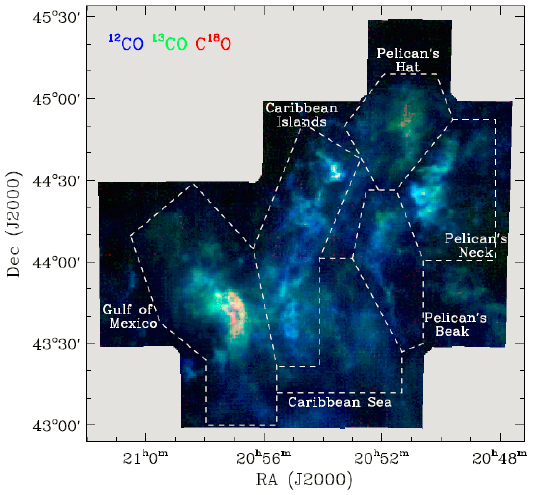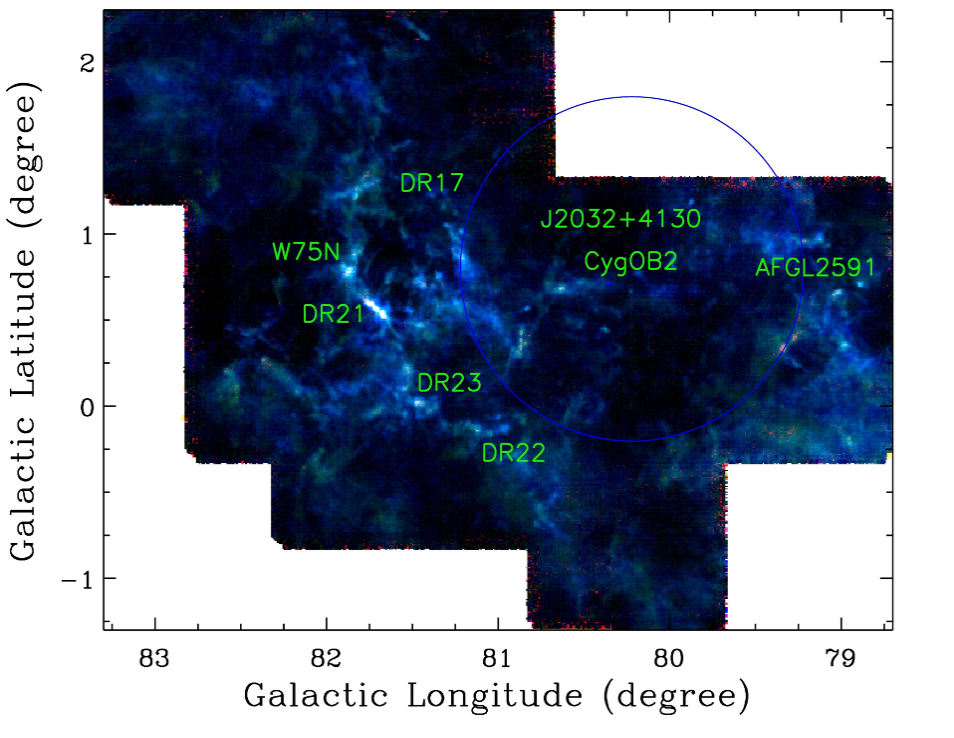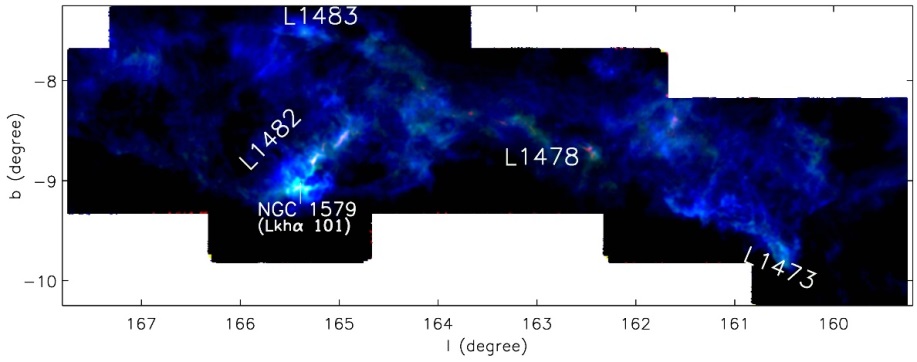I. Introduction
The Milky Way Imaging Scroll Painting (MWISP) project is the first no-bias high sensitive CO survey with such a large scale aiming at the Galactic range of L=[?10.25, 250.25]?, B= [?5.25, 5.25]? and some other area of interest.
Making use of the 13.7m radio telescope of Qinghai observation station, the survey was started from 2011. The 12CO/13CO/C18O (J=1-0) lines are observed simultaneously with the on-the-fly (OTF)observation mode. The target observation region is divided into 10941 cells unit in (L, B) grid for mapping, each with a size of 30′X30′. OTF scans in directions of AZ/EL (also RA/Dec or GA/GL) can be employed. The nominal sensitivity in the survey is set for 0.3 K in 13CO at the resolution of 0.17 km s-1.
To allow the field rotation, a larger size of 45.5′X45.5′ was preserved for each cell in data processing, which results in a certain overlap between neighboring cells. OTF data are re-gridded to 30"X30" (~half beam width) and stored in a FITS cube for each line and for each cell. Further pipeline reductions include data clipping and baseline fitting. Reference positions with a size of > 5'x5' where the sky is free of contaminating molecular emission are carefully searched.
II. Scientific Targets
1. Searching for the new molecular celestial bodies of the Milky Way Galaxy, studying the large-scale distribution and the physical and chemical properties (temperature, column density, line width, abundance, etc.) of molecular gas.
2. Obtaining the internal structure (core, clump mass function, etc.), dynamic process (such as large-scale turbulence) and other new phenomena of the molecular cloud
3. Studying the substructure (hot core, starless core, etc.) of the important star formation regions, finding new young stellar objects (YSOs) and studying their properties (infall & outflow, etc.).
4. Studying the structure and component of the Milky Way Galaxy, such as the galactic center, bar, 3kpc molecular ring, Lindblad ring, outer galaxy, streaming motion, etc., and finding new structure and component.
5. Studying and the interactions and finding new phenomena among molecular clouds, HII regions and supernova remnants (SNRs), studying the origin of diffuse γ radio sources.
The scientific targets above are constantly updated along with the progress of the survey.
III. Examples of Scientific Output
Up to 2015, the survey has already completed about one third of the plan. Some results and discoveries have been achieved. Examples are as the following:
1. Discovery of a New Spiral Arm
A new segment of a spiral arm between Galactocentric radii of 15 and 19 kpc that apparently lies beyond the Outer Arm in the second Galactic quadrant has been identified. The new arm appears to be the extension of the distant arm recently discovered by Dame & Thaddeus (2011) as well as the Scutum?Centaurus Arm into the outer second quadrant. Fig.1. shows an artist’s conception of the Milky Way with the newly discovered arm over plotted.

Fig.1. An artist’s conception of the Milky Way (R. Hurt: NASA/JPL-Caltech/SSC). The circles indicate the molecular clouds of the newly discovered spiral arm. The cyan solid line traces the fitting results to all available data. (Sun et al. 2015, ApJ, 798L, 27S)
2. The North American and Pelican Nebulae
The North American (NGC 7000) and Pelican (IC 5070) Nebulae (referred to as the “NAN complex”) are together one of the nearby (~600 pc, Laugalys & Straiˇzys 2002) star forming regions with large numbers of massive stars. This is the next closest region showing signs of massive star formation after Orion. Fig.2 shows the A composite color image of the NAN complex.

Fig.2. A composite color image of the NAN complex made from the integrated intensity map, with 12CO in blue, 13CO in green, and C18O in red, respectively. The outlines of the six regions with their names are also plotted. (Zhang et al. 2014, AJ, 147, 64Z)
3. The Cygnus X region
The Cygnus X region is known under active star formation, especially for massive stars. Our first-round mapping in this regions covered the active regions of AFGL 2591, Cyg OB2, Dr 21, and W75N. Fig.3 shows a color composite map of the integrated intensity of 12CO/13CO/C18O lines. Abundant molecular structures in this area are successfully revealed with high image dynamic range and fidelity.

Fig.3. A color composite image of Cygnus X region made from the integrated intensities of 12CO/13CO/C18O lines, where blue in 12CO, yellow in 13CO, and red in C18O, respectively (image prepared by S.J. Shao).
4. The California Molecular Cloud
California Molecular Cloud (CMC) is a nearby giant molecular cloud complex in Perseus at a distance of 450 pc (Lada, C. et al. 2009, ApJ, 703, 52). The presence of large-scale molecular gas and its apparent low activity of star formation make this region to be of particular interests. We mapped part of this region during the survey and the initial results are illustrated in Fig.4 by a color composite map of the CO lines.

Fig.4. The 12CO/13CO/C18O color composite image of California Molecular Cloud (CMC). Color coding is made in the way same as that in Fig.3. Extended filamentary clouds are clearly revealed by the survey (image prepared by Q. Liu).
5. Supernova Remnant G22.7-0.2
Supernova remnant (SNR) G22.7?0.2, with a diameter of 26’, is listed in the catalog of Green (1991). The remnant is located in a complex field with multiple HII regions and an adjacent SNR G23.3?0.3 (W41) that has been studied less. SNR G22.7?0.2 shows a faint shell structure in the radio emission and it displays a concave structure on the southern part of the shell. There are numerous mid-infrared filaments evident at 5.8–8μm in coincidence with the radio shell of the remnant, which was suspected as a possible region of SNR–MC interaction (Reach et al. 2006).

Fig.5. 12CO (J=1–0; blue), 13CO (J=1–0; green), and C18O (J=1–0; red) intensity maps with a linear scale of SNR G22.7?0.2 overlaid with the VGPS 1.4 GHz radio continuum emission contours.
The red rectangle and the yellow rectangle show the region of GMC G23.0?0.4W and GMC G22.6?0.2, respectively. The red circle shows the location of HESS J1832–093 (Laffon et al. 2013). SNR W41
(G23.3?0.3) is located to the left of SNR G22.7?0.2. (Su et al. 2014, ApJ, 796, 122S)
6. Supernova Remnant G127.1+0.5
SNR G127.1+0.5 has been identified as a shell-type SNR by Caswell (1977) and Pauls (1977). Together with the central compact sources, they have been studied in many wavelengths. Previous studies have revealed the possibility of an SNR–MC interaction. The interpretation and derive the characteristic parameters of the SNR–MC interaction and SNR evolution are discussed in this work.

Fig.6. Left: integrated intensity map of 12CO (J=1–0) emission overlaid with the 1420 MHz radio continuum contours. The blue and red arrows indicate the straight and curved parts of the filament, which are out of the remnant and in the remnant, respectively. Right: position-velocity map of 12CO (J=1–0) emission integrated over the strip region indicated by the arrows in the left panel. The blue and red arrows correspond to that in the left panel. (Zhou et al. 2014, ApJ, 791, 109Z)
IV. Data Management
Data collection, inspection, and initial reductions are of huge tasks. Some of the additional time will be spend on the detailed analysis on individual region and the results will be published in a timely way. Progress of the survey can be monitored from the web site of MWISP at http://www.radioast.csdb.cn/. The final data will be reduced by consistent pipelines to ensure the uniformity and the whole data product will be in FITS spectral cubes. We will not see the possibility to analyze all of the data in very detail, however, the complete set of raw data generated by the MWISP survey will be finally released for open access. Early access of the data for specific area is possible through mutual collaboration. The download address of the MWISP data use application form is http://english.dlh.pmo.cas.cn/op/odp/

